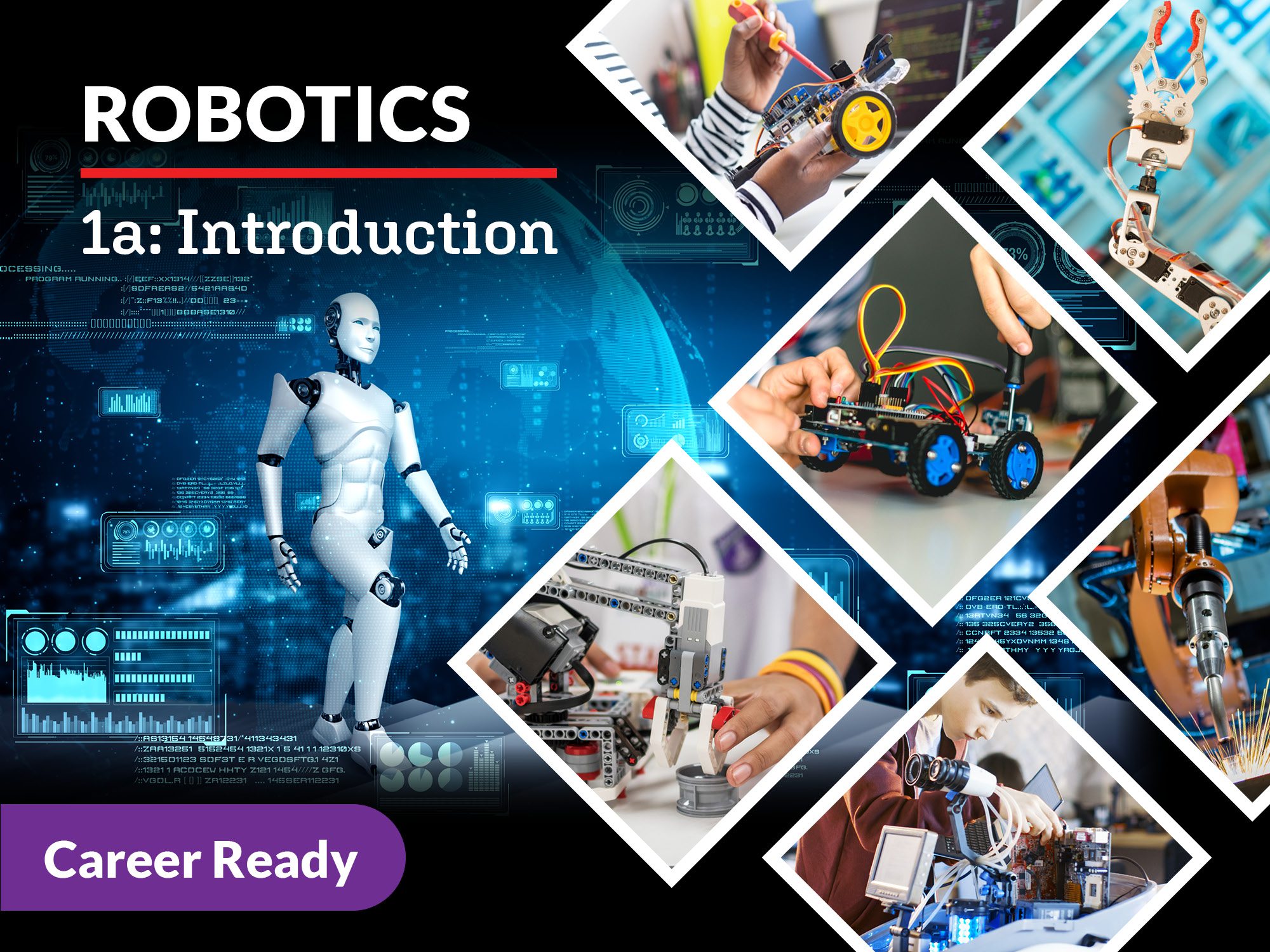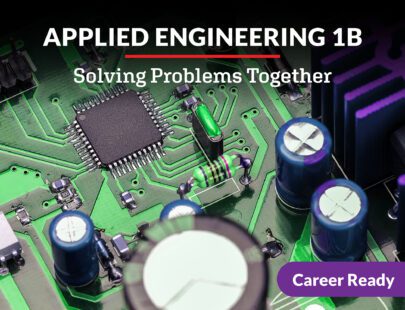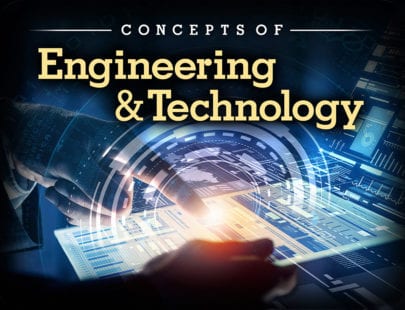
Robotics 1a: Introduction
Are you fascinated with how machines work? Robots are machines, and they are all around us, from helping doctors in surgeries to helping to keep our homes clean. Explore the physics, mechanics, motion, and the engineering design and construction aspects used to develop robots. Learn how models are created through both sketches and software. Discover STEM careers and the education needed to enter this high-demand field.
Units at a Glance
Unit 1: Work with Robots
Automation fascinates us! Watching a machine move an object on its own captivates our mind as we attempt to figure out the secrets behind its trickery. In reality, it is all based in math and the sciences of materials. To be able to understand this or create such animated objects, we must take a lesson from those who came before us and made those discoveries that will help us build these machines. In this unit, we identify the educational requirements that will qualify us to design, build, or operate robotic machines.
What will you learn in this unit?
- Describe the educational requirements for career goals
- Explain ethical issues and resolutions in STEM careers
- Identify human rights and appropriate etiquette in a diverse workplace
- Explore occupations in industrial robotics and engineering
Unit 2: Health and Safety
Whether you are working virtually, in industry, or in a classroom-training environment, safety is always a priority. There are dangers and risks all around us that we should not take lightly. Even the new appliance, machine, or tool we purchase for home use comes with a certain level of required safety. The attached warning labels and manuals normally alert us as to proper use and hazards. In this unit, we learn what those warning signs are telling us about those dangers, as well as what we should do if there is an emergency!
What will you learn in this unit?
- Identify OSHA standards and how hazards are communicated in the workplace
- Follow general lab safety procedures
- Distinguish between fire prevention and emergency fire procedures
- Explain emergency first-aid procedures
Unit 3: Simple Machines, Mighty Mechanisms
Robots are machines, and they function in our physical realm of touch, sight, and sound and move based on the physics of our reality. Not only that, but many of today’s machines reflect the mechanical concepts that drove the world’s earliest machines—that is, at its most basic, the goal remains one of performing some kind of work, and that work requires energy as an input. And when you are confronted by modern, complex machines, keep in mind that they can always be broken down into their component parts and actions. By understanding the many parts and components used in machines, we can compile our own custom mixes of equipment to design robots that can perform a variety of tasks. In this unit, we will focus on the mechanisms that have evolved to manipulate our physical world.
What will you learn in this unit?
- Describe the use of the six simple machines as they relate to robotics
- Calculate torque as it applies to mechanical advantage
- Determine mechanical advantage of various machines
- Identify various drivetrain systems
Unit 4: Let’s Build a Model
One of the most common problems in this world is communication. How do you explain or describe an idea to others, especially with the many languages out there? Since a picture is supposed to be worth a thousand words, the visual arts can be an effective way to get a point across. But in robotics, it doesn’t stop there! Let’s learn how a penciled sketch and a few measurements can be entered into a computer and then sent to be constructed on a machine!
What will you learn in this unit?
- Discuss engineering drawings standards
- Evaluate tools used in computer-aided design
- Enhance your spatial reasoning skills
- Identify measuring tools used in engineering
Unit 5: Robot Mechanics and Motion
Before the computer came the machine, but without the two you wouldn’t have a robot. As robots have become more important in today’s society, their applications and capabilities have vastly increased. Robots are used for all sorts of things now—from assisting doctors in surgeries, to roving the surface of Mars, to helping humans keep their homes clean! To make robots capable of accomplishing such a wide variety of tasks, many different styles of robotic machines have been developed. In this unit we investigate the mechanical side of robotics. We’ll meet robots with human-like hands, robots that weld, robots that hop on one leg, robots that balance on a sphere, robots that fly, and robots that swim! What you might think of as a robot right now will probably change by the end of this unit!
What will you learn in this unit?
- Describe the design and construction of a robotic arm
- Demonstrate knowledge of robotic joints
- Identify various robot end effectors or manipulators
- Explain a variety of robots and their mechanical form
Unit 6: Robot Physics
Robots come at a cost—a cost of time, energy, and material resources, among others. All of these are taken into consideration when designing robotic systems. A robot can be designed to operate very quickly, but if it has to sit and wait for other robots to complete their tasks, then that isn’t efficient. A robot can be designed for extreme heavy lifting, but if all it is moving are boxes of light snacks, then energy is being wasted just in the movement of the robot’s own weight. Robots are not a one-size-fits-all type of solution. They are designed to accomplish a specific set of tasks, hence the evolution of all the different styles you learned about in the last unit. Ultimately, a robot’s design aims to minimize energy loss while maximizing its ability to accomplish its task. Physics calculations used in robotics are quite complicated, but our goal in this unit is to understand the concepts behind the mathematics and be able to see some examples of how these concepts govern the design and control of robots.
What will you learn in this unit?
- Describe the principles of robotic physics
- Discuss linear displacement, velocity, acceleration, and momentum
- Explain angular displacement, velocity, acceleration, and momentum
- Calculate vector forces
- Understand the impact of inertia and momentum on robotics
Unit 7: Engineering Design Methods
Have you seen or heard of a robot and thought to yourself, how did someone come up with that idea? Or perhaps the thought is—of course! Why didn’t I think of that? Once a robot is invented and available to help solve problems in our lives, we often can’t imagine a life without it. But before that robot’s invention, someone had to identify that problem and then find the right robotic solution! In this unit, we’ll go through the process of identifying a problem, coming up with a design solution, and then refining that solution to build a robot. This same method is used in the development of all kinds of products and engineering solutions, and it takes on an even more crucial role when it comes to robotics because of the applications they are used in. Let’s dive in!
What will you learn in this unit?
- Keep an engineering notebook
- Understand the role of criteria and constraints in the design process
- Apply the engineering design process for robotics
- Identify aspects of quality in a product
- Describe tools used for prototyping and mass production
Unit 8: Keeping Robots and Coworkers Happy
Here you are, at the final unit of this course. You’ve learned about so many components of the field of robotics. But how does it all fit together? How do we apply all of these skills and processes to actually design a robotic system? In this unit, we will take you on a hypothetical field trip into a design project for an automation firm called eDynamics. In this story, you play the role of a junior mechanical engineer trying to make their way in a brand new job. You will be challenged technically and interpersonally, and your professionalism will be put to the test. Will things go as planned? Read on to find out!
What will you learn in this unit?
- Explain the importance of effective teamwork in the fields of engineering and robotics
- Employ critical thinking skills to solve problems both independently and as a team
- Conduct technical research to gather decision-making information
- Identify appropriate workplace standards of behavior
- Understand the process of developing, analyzing, and testing a prototype
Required Materials
Physical
- Sound recording device
- Two-button mouse with middle scroll wheel
- Video recording device
- Digital camera or scanner
Software
- Word processing software
- Presentation software
- Spreadsheet software
- Google Drawings (requires login)
- Onshape (requires login)
- CoppeliaSim Edu


